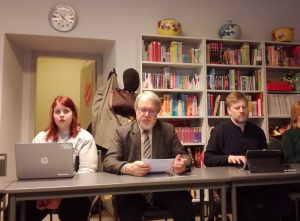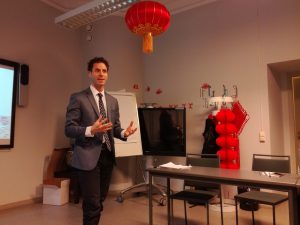On Wednesday 4 March 2020, a partner of the Finnish China Law Center, the Confucius Institute at the University of Helsinki held a seminar on the topic of ‘Belt and Road Initiative in Russia and Kazakhstan’.
Considering that 7 years have passed since the Belt and Road Initiative (BRI) was introduced by President Xi Jinping at Nazarbayev University in 2013 and there has been increasing awareness of this project and suspicion of its exact impact and influence, the Seminar aimed to provide up-to-date views and perspectives of two experts from Russia and Kazakhstan regarding the BRI.

The Seminar began with a presentation on ‘The Belt and Road Initiative: Views from Russia’ from Professor Nikolay Samoylov (St. Petersburg State University). Professor Samoylov remarked that the Russian Government regards the BRI as having economic and political significance since boosting Russia and China’s relation and promoting alignment of the Eurasian Economic Union and the Silk Road Economic Belt are elements of the BRI. For Russian politicians and leaders, the future of the Eurasian Economic Union is very important, and they wish to connect it with the Chinese BRI.
He added that the BRI is becoming an increasingly crucial aspect of China and Russia’s cooperation as shown through the active negotiation and consultation process of promoting Eurasian economic integration within the framework of the Eurasian Economic Union and the Silk Road Economic Belt. In 2017, the Eurasian Economic Commission drew up a list of prioritized projects to be implemented by Eurasian countries in support of the Silk Road Economic Belt project. A majority of these projects involve the construction of new roads and modernization of existing roads, establishment of transport and logistic centers, and development of key transport hubs. Russia has proposed 3 main logistic projects, including the construction of a high-speed railway between Beijing and Europe, motorway connecting China, Kazakhstan, Russia, Belarus, and Europe, and development of the Northern sea route. Professor Samoylov noted that Russia has set out the goal that over the next 6 years, it shall increase the full capacity of the Baikal – Amur Main Line and the trans-Siberian railway to 880 million tonnes per year, cut fright delivery time from far East to the Western border of Russia to 7 days, increase the volume of transit of shipments on Russian railways almost four-folds, thus turning the country into a global leader in cross Asia transit shipping. Therefore, these projects are especially significant to Russia.

Over the past 5 years, Russian international relation experts have produced a large quantity of academic and expert publications and debates designed to explain the BRI to the society and political elites. There is a firm opinion that the implementation of the BRI would inevitably strengthen China’s influence in the Central Asia region. However, some expert groups opine that the Silk Road Economic Belt is essential for changing the entire global geopolitics. They are convinced that Russia should retain the role of a regional leader in Central Asia and that integration with the Silk Road Economic Belt is not an obstacle, but a facilitating factor. Others view Beijing’s actions not as an opportunity but a threat to Russian national defense. In between these two extreme trends, another group tries to explain Beijing’s actions through their own interpretation of social-economic goals in China. They contend that China’s priority is to solve China’s social-economic task which is not possible without an active foreign policy. This task focuses on 3 areas: creating new transport and logistic infrastructure to link Europe and Asia via Russia, directing Chinese investment in the high-tech industry and engaging China through investment, loan, and technology, implementation of projects that use new instruments for the development of Russian Far East and northern sea route.
The Seminar continued with a second presentation titled ‘How is BRI Playing in Kazakhstan? Findings from a Survey’ by Professor Chris Primiano (KIMEP University) which focused on Kazakhstan and particularly how students at KIMEP University view the BRI. Professor Primiano explained that university students in Kazakhstan represent the future elites and so it is important to get engaged with students at KIMEP, one of the leading universities in Kazakhstan to understand how they view the Chinese BRI.
Professor Primiano observed that there is tremendous discontent in Kazakhstan directed at China for two main reasons being Chinese FDI and the situation in Xinjiang with the vocational camps. The Chinese FDI comes with Chinese workers in contrast to western FDI. In order to accept one of these infrastructure projects the host government also accepts Chinese workers. The perception of jobs being taken away from locals in Kazakhstan and that the Chinese workers are benefiting more than Kazakhstani nationals create a good amount of push-back. The actions of China in Xinjiang also add to the disapproval from certain segments of Kazakhstan since there have been many ethnic Kazakhs or Kazakhstani nationals who have been in these vocational camps.

The survey by Professor Primiano and his colleagues aims at finding out whether participants view the BRI as a win-win/mutually beneficial situation, or as China benefiting itself at the expense of Kazakhstan. The survey questions were related to demographic variables (age, gender, income, rural or urban, etc) and attitudinal variables impacting one’s views on the BRI i.e. What are their views on democracy? and Do they equate democracy with economic development than with political rights?
Some general trends can be inferred from the survey. Those whose parents earn higher incomes viewed China more favorably. Those whose parents have higher education view China in a more positive way. The students who equate democracy with economic development would view China more positively and those who equate democracy with social or political rights concept will have a negative take on China. The people spending more time reading and watching TV news tended to have a more unfavorable view of China.
Professor Primiano explained that the survey employed both open-ended and closed-ended questions, for example: What do you associate with China? Why is China involved in Central Asia with infrastructure and development projects? And does the BRI create a win-win for Kazakhstan? etc. Regarding the first question, 206 of the respondents had positive views about China’s BRI, associating it with advancing globalization, trade and mutual benefits. 27% wrote that BRI was about neo-colonialism with China benefiting at the expense of other countries. Some respondents said they ‘never heard of this’ or ‘do not know anything about the BRI.’ On the second question, less than 3% of the participants replied that the BRI was not mainstream in Central Asia. The majority said that China’s purpose was its own interests only. 30% opined that it was to advance the interests of China and other countries in Central Asia. The remaining 11% answered with ‘don’t know’ or ‘not sure.’ Relating to the third question, 60% felt that they lack proper information to comment on the matter.
To sum up about the survey, Professor Primiano remarked that a strong majority were not well aware of this initiative while surprisingly, China selected Kazakhstan as a place to announce BRI and there have been significant investments and tremendous funding from China. In the future, survey experiments will be done with treatment and control groups provided with additional information on the BRI.
